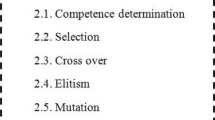Abstract
This paper proposes the duplex route generation method to evolve the bus route network which is robust to environmental changes and aims at investigating its effectiveness through the experiments. In this study, the “duplex route” corresponds to the alternative route and it has the advantage of not requiring to modify the route network in the environmental changes. To generate the duplex routes, this study employs MOEA/D as the base optimization method and introduces the following two operations in MOEA/D to increase the duplex routes while improving the fitness: (1) the crossover operation to generate the duplex routes, which is improved from the crossover operation in SEAMO2 [9] that evolves unique routes, and (2) the priority solution update operation in the enhanced MOEA/D [4] to maintain a diversity of the routes which contributes to improving the fitness. The experiments on Mandl’s benchmark problem has revealed: (1) the proposed crossover operation can generate many duplex networks as compared to the original crossover operation; (2) the priority solution update operation improves the fitness, i.e., a minimization of the passenger transportation time and the number of buses; and (3) integration of the two operations improves both the number of duplex routes and fitness, which is hard to be achieved by either operation.
Access this chapter
Tax calculation will be finalised at checkout
Purchases are for personal use only
Similar content being viewed by others
References
Baaj Hadi, M., Mahmassani, H.S.: TRUST: a LISP program for the analysis of transit route configurations. Transp. Res. Rec. 1283, 125–135 (1990)
Buba, A.T., Lee, L.S.: A differential evolution for simultaneous transit network design and frequency setting problem. Exp. Syst. Appl. 106, 277–289 (2018)
Byrne, B.F.: Public transportation line positions and headways for minimum user and system cost in a radial case. Transp. Res. 9(2–3), 97–102 (1975)
Chen, C.M., Chen, Y.P., Zhang, Q.: Enhancing MOEA/D with guided mutation and priority update for multi-objective optimization. In: 2009 IEEE Congress on Evolutionary Computation, May 2009, pp. 209–216 (2009)
Kitagawa, H., Sato, K., Takadama, K.: Multiagent-based sustainable bus route optimization in disaster. J. Inf. Process. 22(2), 235–242 (2014)
Majima, T., Takadama, K., Watanabe, D., Katuhara, M.: Characteristic of passenger’s route selection and generation of public transport network. SICE J. Control Measur. Syst. Integ. 8(1), 67–73 (2015)
Mandl, C.E.: Evaluation and optimization of urban public transportation networks. Eur. J. Oper. Res. 5(6), 396–404 (1980)
Mayumi, S.: The rise of NGOs/NPOs in emergency relief in the great east Japan earthquake. Jap. Soc. Innov. J. 2(1), 26–35 (2012)
Mumford, C.L.: New heuristic and evolutionary operators for the multi-objective urban transit routing problem. In: 2013 IEEE Congress on Evolutionary Computation, pp. 939–946 (2013)
Zhang, Q., Li, H.: MOEA/D: a multiobjective evolutionary algorithm based on decomposition. IEEE Trans. Evol. Comput. 11(6), 712–731 (2007)
Author information
Authors and Affiliations
Corresponding author
Editor information
Editors and Affiliations
Rights and permissions
Copyright information
© 2021 Springer Nature Switzerland AG
About this paper
Cite this paper
Kajihara, S., Sato, H., Takadama, K. (2021). Generating Duplex Routes for Robust Bus Transport Network by Improved Multi-objective Evolutionary Algorithm Based on Decomposition. In: Castillo, P.A., Jiménez Laredo, J.L. (eds) Applications of Evolutionary Computation. EvoApplications 2021. Lecture Notes in Computer Science(), vol 12694. Springer, Cham. https://doi.org/10.1007/978-3-030-72699-7_5
Download citation
DOI: https://doi.org/10.1007/978-3-030-72699-7_5
Published:
Publisher Name: Springer, Cham
Print ISBN: 978-3-030-72698-0
Online ISBN: 978-3-030-72699-7
eBook Packages: Computer ScienceComputer Science (R0)




